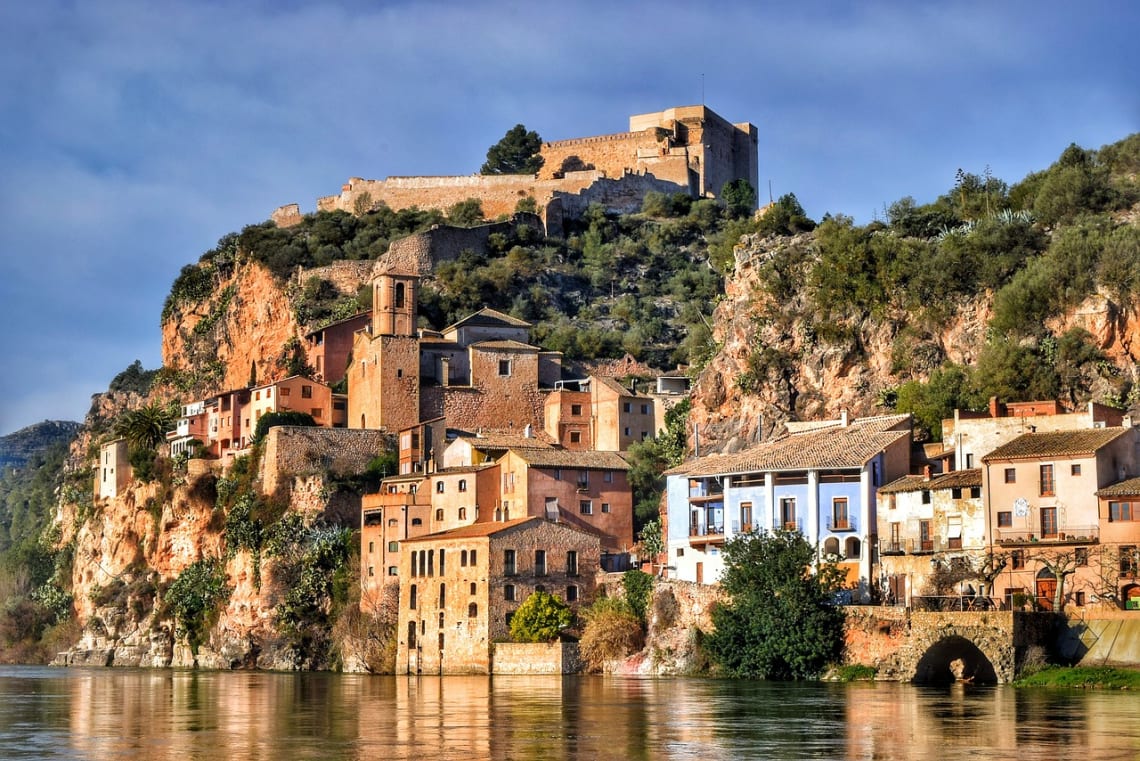Planning a trip to Spain: A guide to budget, destinations, and more
Discover essential tips for planning a trip to Spain, including must-see destinations, travel advice, and local insights to make your journey affordable and unforgettable.
12min

Spain is a country of contrasts, where ancient history meets vibrant modernity, and dramatic landscapes stretch from rugged mountains to some of the best beaches in Europe.
From the art and architecture of Barcelona to the lively tapas culture of Andalusia and the sun-drenched shores of the Mediterranean, travelling around Spain unveils a rich tapestry of experiences. With each region offering its own distinct flavor, it's no wonder Spain ranks among the world’s top tourist destinations.
Planning a trip to Spain means immersing yourself in its unique blend of cultures, savoring world-class cuisine, and exploring towns steeped in history. This guide will help you make the most of your Spanish adventure.
What to know for planning a trip to Spain

Entry requirements for Spain
One of the best things about visiting Spain is that getting in is relatively simple. Many nationalities, including travelers from the USA, Canada, the UK, Australia, and New Zealand, can enjoy visa-free travel for 90 days within any 180-day period, under the Schengen Agreement.
To ensure a smooth airport check, make sure your passport is valid for at least three months beyond your planned stay. Be prepared to show a return ticket, and, in some cases, accommodation details for your firsts days in Spain and proof of sufficient funds.
You can research the Schengen area and specific visa requirements online. This will help answer any questions about your particular circumstances.
Best time to visit Spain
The high season (June, July and August), is popular for its sunny weather, making it ideal for beach lovers. However, the summer months also bring intense heat, especially in Southern Spain, and very large crowds flocking to popular tourist spots.
For a more comfortable experience, consider the shoulder seasons—spring (April and May) and fall (September and October). During these months, the weather is milder, with pleasant temperatures perfect for exploring cities, hiking, and enjoying outdoor activities without the sweltering heat. Tourist crowds are thinner, allowing you to visit iconic sites like the Alhambra or Sagrada Familia without the long lines.
The low season, from November to March, offers the lowest prices and fewer tourists, but the weather can be unpredictable, especially in the north, with very cold temperatures and occasional rain.
Transportation in Spain
Spain boasts an excellent transportation system, making it easy to explore this captivating country. Whether you prefer the speed of trains, the affordability of buses, or the convenience of flying, Spain has an option for every type of traveler and budget. Here's a breakdown of each mode of transportation:
- Trains
Trains, especially the high-speed RENFE trains, offer an efficient and scenic way to travel between major cities. These modern marvels connect destinations like Madrid, Barcelona, Seville, and Valencia in a flash, making them perfect for covering long distances quickly and comfortably.
The drawback of this mode of transportation is its higher cost, exceeding that of buses and even low-cost flights in many cases.
- Buses
Buses, with ALSA being the major provider, present a budget-friendly alternative for travelling around Spain. They service an extensive network of routes, reaching smaller towns and villages that might not be easily accessible by train. This makes buses an excellent choice if you are not in a hurry and want to save money on your trip.
- Low-cost airlines
Several low-cost airlines, including Vueling, Ryanair, Volotea, and easyJet, operate domestic flights within Spain. They provide an affordable option, especially if you're short on time and want to cover larger distances. However, remember to factor in baggage fees when comparing prices.

Budgeting for your Spanish adventure
When planning a trip to Spain, budgeting is key to making the most of your experience. Spain is known as one of the most affordable destinations in Western Europe, offering good value for money. However, is more expensive than traveling in the Balkans and other Eastern European countries like Czech Republic. This is particularly true in major cities such as Madrid, Barcelona, and those in the Basque Country's —Bilbao and San Sebastián—where prices for accommodation and dining can be significantly higher.
To get a clear picture of your budget, start by exploring accommodation prices on platforms like Booking.com, Airbnb, and Hostelworld. These sites offer a wide range of choices, from budget hostels to mid-range hotels and cozy apartments, allowing you to find something that suits your travel style and budget.
Transportation is another major cost to consider. Renfe, the national rail service, offers routes across the country, connecting major cities and regions. For long-distance bus travel, check prices on Alsa and Flixbus, which are cheaper than trains. If you're flying between destinations, the low-cost airlines mentioned above provide affordable options, and it’s best to book directly through their websites for the best deals.
Food in Spain can be surprisingly affordable if you know where to look. In most cities, you can enjoy a satisfying meal at a local restaurant for around 10-15 Euros. Look for "menu del día" (set menus) offered at lunchtime, which typically includes multiple courses and a drink for a fixed price. Shopping at supermarkets and preparing your own meals is a great way to save money, especially if you're staying in accommodations with kitchen facilities.
Overall, backpacking in Spain can be an incredibly rewarding experience, combining rich cultural experiences with relatively low travel costs. With careful planning and smart budgeting, you can explore this diverse country without breaking the bank, ensuring that your trip is both memorable and affordable.

Planning a trip to Spain: how to save money
Here are some tips to stretch your travel budget further:
Avoid high season
Visiting Spain during the high season in summer can be a costly affair, with prices for flights, accommodation, and attractions soaring as tourists flock to the country’s most popular destinations.
Instead, consider planning your trip during the shoulder seasons—spring (April to June) or fall (September to October). Not only will you find more reasonable prices, but you’ll also enjoy milder weather, which is particularly important if you’re planning to visit Southern Spain, where summer temperatures can be intense.
Additionally, traveling during these times means you’ll encounter fewer crowds, allowing you to explore Spain’s iconic sights at a more relaxed pace.
Book flights and accommodation early
Booking your flights and accommodation early is one of the best strategies for saving money when planning a trip to Spain. The closer you get to your travel dates, the more likely you are to see prices increase, especially in major tourist hubs like Madrid, Barcelona, and the Costa del Sol.
By securing your flights and lodging well in advance, you can lock in lower rates and have a wider range of options to choose from. Early booking also gives you peace of mind, knowing that your accommodations are sorted before prices peak.
Stay in places with cooking facilities
Accommodation with cooking facilities can be a game-changer for your budget. Hostels, guesthouses, and Airbnb rentals that offer kitchens give you the freedom to prepare your own meals, which is much cheaper than dining out for every meal.
Spain has an abundance of local markets and grocery stores where you can pick up fresh, regional ingredients to cook with, allowing you to enjoy delicious Spanish cuisine at a fraction of the cost.
Walk a lot and carry a reusable water bottle
One of the best ways to explore Spain is on foot. Cities like Barcelona, Seville, and Madrid are incredibly walkable, with charming streets and hidden gems that are often missed when using public transport. Walking not only saves you money on transportation but also allows you to fully immerse yourself in the local culture.
To keep costs down and stay hydrated, bring a reusable water bottle with you. Many Spanish cities have public fountains where you can refill your bottle for free, reducing the need to buy bottled water throughout the day and helping you stay refreshed as you explore.
Join free walking tours and look for free attractions
Many cities offer free walking tours that provide a fantastic introduction to the local area. These tours are typically led by knowledgeable guides who are passionate about their city and can offer valuable insights that you won’t find in guidebooks. While the tours are free, it’s customary to tip your guide at the end. Search on Sandemans New Europe, GuruWalk, Freetour.com, Buendía Tours and Strawberry Tours to see all the available tours.
In addition to walking tours, many of Spain’s top museums offer free entry on certain days or during specific hours. For example, Madrid’s Prado Museum is free on weekday evenings, and Barcelona’s Picasso Museum offers free admission on Thursday afternoons. Planning your visits around these times can save you a significant amount on entrance fees.
Explore cheaper regions
While cities like Madrid and Barcelona are must-see destinations, they are the most expensive places to visit in Spain. If you’re looking to stretch your budget, consider exploring less touristy regions like Asturias, Galicia, and Andalusia. These areas are not only more affordable but also incredibly rich in culture, history, and natural beauty.
Whether it’s hiking in the Picos de Europa, discovering the rugged coastlines of Galicia, or wandering through the picturesque white villages of Andalusia, these regions offer authentic Spanish experiences at a fraction of the cost.
Volunteer in Spain
If you want to have life-changing experiences while traveling on a budget, consider volunteering in Spain through Worldpackers. These work-exchange programs gives you the opportunity to help in different local projects for a couple of hours a day, and get free accommodation on site and other perks in return (like meals and access to activities).
From hostels in popular destinations to organic farms, holistic centers, animal shelters and more, there's a wide range of volunteering opportunities according to your interests and skills.
Besides saving money on your trip, taking part in volunteer activities will give you an insight into the culture, help you build relationships with locals and other travelers, develop new skills (like learning Spanish), and create memories to last a lifetime.
You can read the experience of fellow volunteers for inspiration: "What it's like to experience a Worldpackers homestay in Madrid" and "Volunteering as a social media manager in Las Palmas de Gran Canaria, Spain".

Top destinations to visit in Spain
For sure you already know and most probably have Barcelona and Madrid on your list of must-visit places. We have written extensively about these two cities, so let's explore other destinations to consider:
Seville: A feast for the senses
Stepping into Seville feels like entering a vibrant tapestry of history, culture, and rhythm. The capital of Andalusia is famed for its stunning architecture, from the majestic Giralda tower to the intricate designs of the Alcázar Palace.
As you wander through the narrow, cobblestone streets of the Santa Cruz neighborhood, the scent of orange blossoms and the sound of flamenco music fill the air.
Don’t miss the chance to experience a traditional tapas crawl, hopping from one bar to the next, savoring local delicacies like jamón ibérico and gazpacho. Seville’s lively festivals, especially Semana Santa and Feria de Abril, are some of the most spectacular in Europe, offering a deep dive into the city’s rich traditions and joyful spirit.
Granada: Where history and nature converge
Granada is where the grandeur of Moorish history meets the stunning natural backdrop of the Sierra Nevada mountains.
The Alhambra, an exquisite palace and fortress complex, stands as a testament to the city’s Islamic heritage and is one of Spain’s most iconic landmarks. Beyond the Alhambra, Granada’s Albayzín district invites you to lose yourself in its labyrinth of whitewashed streets, offering glimpses of vibrant gardens and scenic viewpoints.
The city’s youthful energy, thanks in part to its large student population, ensures a dynamic nightlife and an array of cultural events. Don’t leave without experiencing a traditional tea in one of the Moroccan-style teterías or savoring a complimentary tapa with your drink, a beloved local tradition.
Málaga: Sun, sea, and culture
The birthplace of Picasso is much more than just a gateway to the Costa del Sol. Málaga is a lively port city that combines sun-drenched beaches with a rich cultural scene.
Stroll along the renovated port area, Muelle Uno, where you’ll find chic boutiques, art galleries, and waterfront dining options. Art enthusiasts will appreciate the Picasso Museum and the Centre Pompidou Málaga, while history buffs can explore the ancient Alcazaba fortress and the nearby Gibralfaro Castle. The city’s mild climate makes it a year-round destination, perfect for enjoying its outdoor terraces, lively markets, and, of course, the stunning beaches just minutes from the city center.

Córdoba: A glimpse into Spain’s Moorish past
In Córdoba, the past is ever-present, with its breathtaking Mezquita-Catedral standing as a symbol of the city’s layered history. This remarkable structure, originally a mosque and later converted into a cathedral, is a stunning example of Islamic architecture.
Wandering through the city’s historic center, you’ll discover narrow, winding streets adorned with colorful flowers and hidden courtyards. Córdoba is also famous for its annual Patios Festival, where locals open their doors to showcase their beautifully decorated courtyards.
The city’s Roman bridge and the remains of the ancient Medina Azahara are also must-see attractions, offering a deeper understanding of Córdoba’s significance in Spain’s history.
Valencia: The city of arts and sciences
Valencia is a city that perfectly blends the old with the new. Its futuristic City of Arts and Sciences complex, with its striking architecture and interactive exhibits, contrasts beautifully with the historic charm of the old town.
Here, you can explore the Gothic-style Valencia Cathedral and the bustling Central Market, one of Europe’s largest and most vibrant food markets. Valencia is also the birthplace of paella, so be sure to savor an authentic version of this iconic dish at one of the many seaside restaurants.
The city’s wide sandy beaches and the lush Turia Gardens, a park built in a former riverbed, make Valencia a fantastic destination for those seeking both culture and relaxation.
Bilbao: A blend of tradition and modernity
The largest city in the Basque Country, is a fascinating blend of old-world charm and cutting-edge modernity. The city is perhaps best known for the Guggenheim Museum, a stunning piece of contemporary architecture that has become a symbol of Bilbao’s transformation.
Beyond the museum, the Casco Viejo (Old Town) offers a maze of narrow streets filled with traditional pintxos bars, where you can sample the Basque Country’s famous small bites. The city’s riverside promenade and the nearby hills provide excellent opportunities for leisurely strolls and panoramic views.
Bilbao’s unique cultural heritage, marked by its Basque traditions, makes it a must-visit destination in Spain.

Santiago de Compostela: A pilgrimage destination with soul
Santiago de Compostela, the final destination of the famous Camino de Santiago pilgrimage, is a city that exudes history and spirituality. The awe-inspiring Cathedral of Santiago, where the remains of St. James are believed to be buried, is the heart of the city and a UNESCO World Heritage Site.
The old town’s cobblestone streets, lined with centuries-old buildings, create a timeless atmosphere that captivates visitors. Even if you’re not on a pilgrimage, exploring Santiago’s vibrant squares, artisan shops, and local markets is a rewarding experience.
The city’s Galician cuisine, featuring fresh seafood and hearty stews, is also a highlight that should not be missed.
Mallorca and the Balearic Islands: Mediterranean paradise
The Balearic Islands, including Mallorca, Ibiza, Menorca, and Formentera, are some of the most enchanting Spanish islands. Each island offers something unique, from Mallorca’s stunning beaches and rugged mountains to Ibiza’s world-famous nightlife.
In Mallorca, you can explore charming villages like Valldemossa, hike through the Serra de Tramuntana, or relax on one of the island’s many pristine beaches. The island’s capital, Palma, boasts a beautiful cathedral and a lively harbor area. For those seeking tranquility, Menorca’s unspoiled beaches and Formentera’s crystal-clear waters provide the perfect escape. The Balearics are a Mediterranean paradise, offering a mix of natural beauty, vibrant culture, and luxurious relaxation.
Salamanca: The golden city
Often referred to as “La Dorada” (The Golden City), Salamanca is known for its stunning sandstone architecture that glows in the sunlight. The city’s historic center, a UNESCO World Heritage Site, is home to one of Europe’s oldest universities, the University of Salamanca, which has been a center of learning for centuries.
The city’s Plaza Mayor is one of the most beautiful squares in Spain, surrounded by elegant baroque buildings and bustling with activity day and night. Salamanca’s vibrant student population gives the city a lively atmosphere, with plenty of cafes, bars, and cultural events to enjoy.
Toledo: A medieval marvel on the hill
The “city of three cultures,” is a mesmerizing blend of Christian, Muslim, and Jewish heritage. Perched on a hill overlooking the Tagus River, this UNESCO World Heritage Site is a labyrinth of narrow, winding streets that lead to breathtaking historical landmarks.
The majestic Toledo Cathedral, one of the finest examples of Gothic architecture in Spain, dominates the skyline, while the Alcázar fortress offers panoramic views of the city and its surroundings. Toledo’s rich history is evident in every corner, from the ancient synagogues of the Jewish Quarter to the impressive El Greco Museum, dedicated to the renowned painter who made Toledo his home.
Exploring this city feels like stepping back in time, where every building and alleyway tells a story of Spain’s diverse cultural past.

If you liked these tips for planning a trip to Spain, follow Worldpackers social media to keep up with the news: we are on Instagram and Tiktok!











